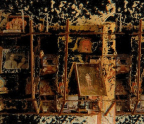“I’m a Little Too Reb ellious for That”: A Conversation with Joi T. Arcand and Winona Wheeler
While doing research to design a catalogue for Kent Monkman’s exhibition at the Robert Langen Art Gallery in Waterloo, ON, which was to be typeset in Cree and English, I decided I wanted the typefaces to echo some of the themes of Monkman’s work. So, I opted for Cartier, designed by Carl Dair in 1968 and dedicated to the people of Canada on the centenary of Confederation,1 and BJ Cree UNI, designed by Bill Jancewicz in 1994 for the Naskapi Development Corporation.2 I was interested in exploring the common misattribution of Cartier as Canada’s first typeface, when it was actually preceded by a Cree typeface by around 120 years.

I was fortunate to come across a text by Winona Wheeler (then Winona Stevenson) called “Calling Badger and the Symbols of the Spirit Language: The Cree Origins of the Syllabic System,” which counterposes two origin stories of the Cree syllabary. On the one hand, the syllabary is said to be the invention of an English missionary and linguist named James Evans. However, Cree oral history tells that it was received by an elder named Calling Badger from the Spirit World. Beyond simply supporting the claim that Cree syllabics precede Cartier as this settler-colonial nation’s first typeface, Wheeler’s text compelled me to wonder about how banal genres of graphic design, like the document, legitimize certain forms of memory over others, and also about how things like typography get wrapped up in the mystification of Canadian settler-colonialism as a benevolent civilizing force, bringing literacy, education and modernization.
When I learned about Joi T. Arcand’s work involving Cree syllabics more recently, I found its speculative charge to be provocative. It didn’t plead or petition to prove anything—it is simply here, in everyday scenes, in neon signs, in what she
You’re reading a preview, subscribe to read more.
Start your free 30 days





